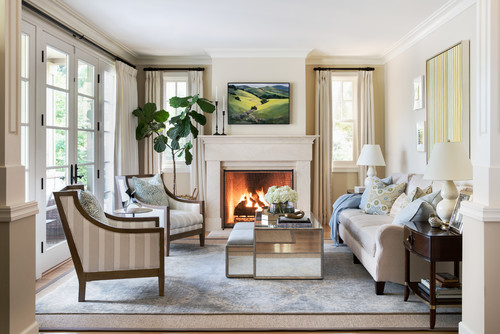Paint is all around us, but how much do you really think about it? OK, thinking or talking about paint sounds, well, just about as exciting as watching it dry. But there are actually some cool things to know about what you can paint and how to paint it.
So whether you're just freshening up your white walls or trying something new with an accent color, you should check out these bright tips. We guarantee that after you read this, you won’t think about paint (or painting) the same way again.
1. Smart paint
A lot of institutions, like high schools and prisons, use colors such as taupe for their hallways because it’s known to be soothing (as is a certain shade of
pink)—but did you know that some colors are thought to make you
smarter? It has been hotly debated whether red and blue can actually affect your ability to take tests. A study from the
Journal of Experimental Psychology showed that red has an adverse effect on, say, SAT performance because it tends to make people anxious and more likely to second-guess themselves. Blue, on the other hand, inspires creative thought, because it’s relaxing and cooling and makes you more attentive to details.
2. How to paint without removing the hardware
If you're spray-painting a piece of furniture, it's kind of tricky to avoid the hinges and locks. Here's a great hack: Simply cover anything you don't want to be painted with a generous layer of petroleum jelly, and spray-paint away. When you’re done, simply rub the coated areas with a paper towel and the paint will come right off.
3. Chair lift
Did you know you can paint upholstered chairs? All you need is acrylic or latex paint, fabric medium, and a few more supplies to transform you latest thrift store find into a one-of-a-kind, statement-making piece of furniture. The miracle material is fabric medium, which keeps the paint from drying stiff. For a thorough breakdown of this project, we love this tutorial from
DIY Network. Now nothing is stopping you from having that canary-yellow armchair you’ve always wanted!
4. Mind the sun
When deciding on a paint type, consider how much natural light the room you’re painting is going to experience. The more light a wall gets, the quicker the paint color is going to fade. If you can’t find a UV-resistant paint (these are mostly for exteriors), it’s best to go with the generally
more durable oil-based paint.
5. How to reduce drying time
As previously mentioned, few things are more boring than watching paint dry—but what if you could speed up the process? Paint dries quickest at 70 degrees Fahrenheit, so if you have to paint when temperatures are less than ideal, it’s a good idea to set your thermostat. Be warned that while higher temps can help paint dry, humidity can undo all that work and actually slow down the process, so check the weather report and plan accordingly.
6. Don't believe the label
Even if you bought them at the same time in the same store from the same guy, no two cans of paint are precisely the same color. The best way to level out the minor differences in shades is to simply mix your cans into one container. If you have two gallons of paint, combine them into one 5-gallon bucket. Once mixed, the subtle differences blend away.
7. Beware! New paint smell = bad for your health
That distinctive scent of a newly painted house is—and we’re sorry to break it to you—really, really toxic. On a typical day, volatile organic compound levels in a home are about two to five times higher than they are outside. But when you paint, those indoor pollution levels could reach up to 1,000 times higher. The good news is that you don't have to vacate your house for a week after painting.
Consumer Reports announced a few years back that the federal government was regulating VOC content in paint. There are also brands such as
Mythic that boast zero VOCs and an "ultra low odor."
8. Adhere to the 60-30-10 rule
A key rule of thumb for maintaining a balanced color scheme in a room is the trusted interior design equation: 60-30-10. Roughly 60% of your room should be the dominant color (this is generally the wall color). The next 30% should represent a secondary color—accent walls, a painted bookcase, wainscoting, or furniture such as a large-scale sofa. The remaining 10% of the color scheme should be accented with art and accessories.
9. Smart storage
For those times when you need to touch up your walls or furniture, keep an extra can of the original paint on hand. To extend the lifespan of your paint, make sure to store at the optimum temperature range of 55 to 90 degrees. Before you store your leftover paint, close the lid really well (use a hammer to make sure it’s firmly sealed), and then flip the can upside down. This will prevent air from getting into the can.
You can also ditch the metal cans and store paint in separate containers. Just use a funnel to empty the can into an airtight jar.
10. Chill out
Whether you hear a knock at the door or experience arm fatigue, chances are you're going to have to put down your paint roller before you can finish painting the whole room. To keep it from getting all crusty, just wrap the roller in plastic wrap and place it in the refrigerator. The roller will be ready to go when you're ready to keep chugging along.





